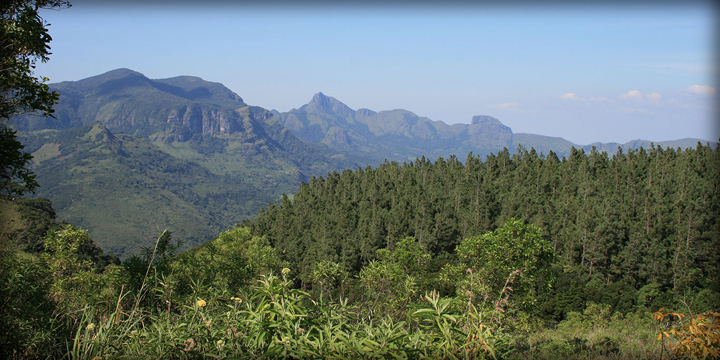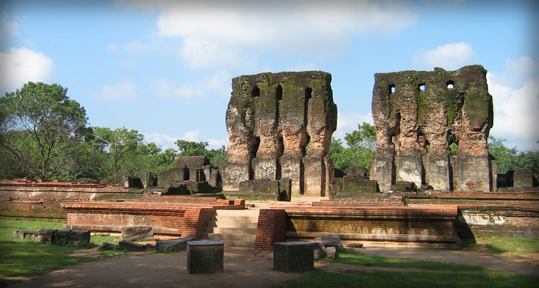The
significance of Dumbara
 The people of the Polonnaruwa kingdom have strong links with Dumbara.
Former MP S.B. Karalliyadde, ventures to analyse some of the most
important antecedents in this short essay: The people of the Polonnaruwa kingdom have strong links with Dumbara.
Former MP S.B. Karalliyadde, ventures to analyse some of the most
important antecedents in this short essay:
Pulathisipura is a kingdom with a long standing and unprecedented
past founded by Risi Pulasthi who lived about five thousand years before
the Buddha was born. When Jesus Christ was born, Dumbara had a
flourishing kingdom from the Vijayaraja Dynasty and Chulabaya (34-35)
was our ruler. The mighty emperor Ravana, son of Pulasthi was a ruler
here.
Ravana has left the impression of his rule by place names such as
Ravan-oya Ravana-elle, Seethakotuwa, Udurawana Yatirawana and many other
place names in Dumbara alone. During the last colonial rule it was late
W.T.B. Karalliyadda who was the Rate Mahattaya of Polonnaruwa and
Tamankaduwa. He was the first member of State Council to represent
Matale District and a part of Polonnaruwa, which was under Matale
District.
This in short will show the links of ancient Pulathisipura or
Polonnaruwa with Dumbrasta or Dumbara today and the President's visit
further reinforces and strengthens our historical relations.
Polonnaruwa was our second capital and the kingdom after the fall of
Anuradhapura. The animal infested jungles in Polonnaruwa were cleared
for human habitation and water from the diversion from Minipe to
Minneriya and Kavudulla tanks were taken by King Mahasen a native of
Dumbara.
This Dumbara son is worshiped to-day as 'Minneriya Deiya' and anyone
entering Polonnaruwa make it a point to pay homage at the Minneriya
Devalaya.
When the kingdom was deserted for twenty one years (1215-1236) after
the Maga invasion, it was again Bodhiraja from Galahitiyawa in Dumbara
who chased away the Maga and restored the Polonnaruwa kingdom as
Vijayabahu III.
Suffice it to mention these two incidents show the strong
relationship of these two kingdoms.
There are six written historical and archaeological reasons to show
how Dumbara came to be known, but I give here one simple reason that
could be remembered easily by all and sundry.
Dumbara today
The area covered with mist came to be known as Dumbara. Dumbara soil
had the origin and flourishing of a number of dynasties. Mehenawaras,
Kshatriyas, originated from Dumbara.

President Maithripala Sirisena will attend
the Nikini Poya sermon at the historic Karalliyadda temple
in the Dumbara valley on August 29 He is expected to attend
the event on the invitation of Ven Naranpanawa Ananda Thera,
the Anunayaka of Asigiriya Chapter of the Siyam Mahanikaya
and the Principal of the Asigriya
Maha Pirivena, the institute of Bhikkhu education. |
Others are the Lambakarna dynasty of King Wasaba of Minipe, a
Kshatriya, Wijayaraja, etc. The assassination of Yasalalakatissa by his
gate keeper saw the end of the Wijayaraja dynasty.
Today Dumbara is divided into four Divisional Secretaries Divisions
for easy administration. They are Uda Dumbara, Patha Dumbara, Meda
Dumbara and Minipe. A part of Dumbara now comes in the Kundasale
Divisional Secretary's area.
In the ancient times we had the Maha Malaya kingdom with
Sandagalanuwara (present day Handaganawa) as its' capital.
The ruler was King Kutakannatissa (22-44 BC) of the Vijayaraja
dynasty. The kingdom covered the river basin area up to Maduru Oya and a
part of Uva including Udukinda and Yatikinda. Rev. Thotagamuwe Sri
Rahula Sangaraja Thera in Kavyasekaraya mentions about the kings from
Dumbara thus,
"Sirisangabo Nirindu - Vikum vedi Mahasen radu
Kithsirime Nirindu - Bujas Mahanam Kumaradas radu"
It was during the reign of Kithsirimevan that the sacred tooth relic
was brought to Lanka. Out of the nine Parakramabahu kings who ruled in
Lanka, seven are from Dumbara Pansiya Pattu. Vijayabahu II, Vijayabahu
III and Gajabahu II are from Dumbara. The majority of those who ruled
under the name of Buwanekabahu are from Dumbara. Each one of them left
an indelible mark and contributed to our history, a unique service which
cannot be mentioned in a short eulogy.
The great gift
Dumbara gifted to the nation three of the Sangaraja Maha Theras
during Sitawaka, Dedigama and Kotte eras. They are Uttaramulla Sri
Rahula, his chief pupil Keragala Wanaratana, and Nephew Totagamuwe Sri
Rahula. After they were elevated to the post of Sangaraja they lived in
Wattala Maha Vehera, Keragala Wanaratana pirivena and Totagamuwe
Pirivena.
According to Buddhist literature and belief two of the Bodhisatwa who
will attain Buddhahood are from Dumbara soil. One is King Sri Sangabo
(251-253 AD) from Minipe and the other is Natha, the god who was
venerated by all Buddhists. He was in Dumbara until Pitiye Deiya a soil
god chased him away in a battle at Yakgahapitiya.
God Natha is believed to have lived after this incident at the
premises of the present Natha Devale in Senkadagala. God Natha is
believed to be the Maithree Bodhisathva.
I must also mention the names of other Dumbara notables, whose names
remain immortal in our history.
Buwaneka Bahu II who had a beautiful daughter - Pathmini - whose
beauty was known among the Princes of India and other foreign soils
committed suicide by jumping into a fire from the king's palace at
Galenuwara (present Meda Mahanuwara) because she refused to be the queen
of Wasthuhamy, alias Wathhimi, son of Hameershankhan, a Malay whose son
the king adopted and later killed the king and became Parakrama Bahu IV
alias Pandita Parakrama Bahu to rule from Kurunegala (1302-1326).
Woman of destiny
The second is the woman of destiny who fled to Mannar with her
parents to escape the wrath of Rajasinghe of Sitawaka and joined the
Portuguese. She became the Queen of Senkadagala in 1592. This was a
period when every Sinhala prince who had a right to the Senkadagala
throne joined the Portuguese. Yamasinghe Bandara Don was baptised Don
Jao, Nikapitiya Bandara was baptised Don Phillip and Tammita Bandara,
Don Francis Barato.
Kusumasana Devi who was also baptised Dona Catherina with
Wimaladharmasuriya defeated Rajasinghe I at Balana and the Portuguese at
Danture and established the Senkadagala Kingdom once again. She
inaugurated a line of kings who ruled for over one and half centuries.
Kusumasana Devi brought the Tooth Relic from Delgamuvihare and
deposited it in the Dalada Maligawa in Kandy. If not for her, we would
have been a Portuguese colony and the Sinhala race eliminated. There
would be no Buddhists, or Buddhism in this country. There would have
been no Dalada Maligawa to call a world heritage building.
It is in the casket that she got cut from a single gem stone from
Menikdiwela that the sacred relic was deposited and brought to
Senkadagala from Sabaragamuwa.
To this day the relic lies in this casket carved out of a single gem.
It was the craftsmen of Yatinuwara whose talents and craftsmanship that
preserve the sacred object. |

